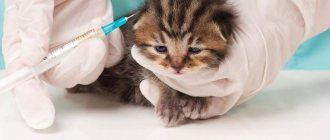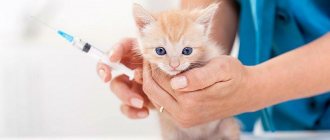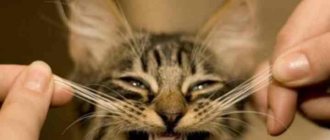In this article, we have collected the official rules: what documents and vaccinations a pet needs before flying, where to get them, what animals can and cannot be transported on airplanes.
Click to go to the desired section:
- What documents and vaccinations are needed to take a pet out of Russia?
- Which animals need permission from Rosselkhoznadzor for export and import and how to obtain it
- How to import an animal to Europe and other countries (with a self-test checklist)
- How to bring an animal to Russia
- Do I need to declare dogs, cats and other animals?
- What is a CITES permit and who needs to get one?
- What documents are needed to fly within Russia?
- Which animals are prohibited from being transported on airplanes and what to do if yours is one of them
- Is it possible to transport puppies and kittens by plane - in Russia and abroad?
How to take a pet abroad
Before flying abroad, you need to take into account the rules of two countries: the point of export and the point of entry.
If the journey begins in Russia, first check how to properly export an animal from our country and what is required for import into another.
To return with a pet from abroad to your homeland, find out the rules in reverse order: how to take a pet from another country and bring it to Russia.
Export of animals from Russia
Dogs and cats
You can export your pet dogs and cats
Documents needed:
1) International veterinary passport , which contains notes on microchipping, vaccinations and deworming treatment. You can get a veterinary passport at the veterinary clinic at the same time as microchipping or vaccinations.
• Microchip implantation . Identification of an animal using a microchip is optional in Russia, but microchipping is required to enter most other countries. Microchipping must be done strictly before rabies vaccination, otherwise the animal will not be allowed into Europe. The process is quick and painless: a capsule the size of a grain of rice is inserted into the pet’s withers. A sticker with a barcode and a 15-digit microchip code is pasted into the veterinary passport, and information about the animal is entered into the database.
For most countries, the chip must comply with the ISO 11784 / 11785 standard. If your destination country has a different standard, you will need to carry a suitable scanner with you to read it.
According to European rules, a stamp is also suitable for identification - but only if they were made before July 3, 2011 and are legible. In this case, the animal does not need to be chipped.
• Rabies vaccination : If your pet has not been vaccinated against rabies within the last 12 months, then the vaccination must be done no later than 20 days before the date of border crossing. Please note that the host country may have different rules: in the EU, for example, it is 21 days after the initial vaccination. Choose a vaccine that is recognized in the desired country, for example, Nobivac. Without a rabies vaccination, it will not be possible to take an animal abroad.
In addition to vaccination against rabies, dogs need vaccinations against distemper, hepatitis, viral enteritis, parvo- and adenovirus infections, leptospirosis; cats - from panleukopenia. Stickers about each vaccination with the date, signature and stamp of the doctor are placed in the veterinary passport.
Both dogs and cats must be treated for worms. Animals may require different vaccinations and treatments to enter another country.
2) Veterinary certificate form No. 1 . You need to get it from a state veterinary clinic within 5 days before your trip. Here is a list of suitable clinics in Moscow and St. Petersburg.
What is needed to obtain a veterinary certificate for a cat or dog :
- veterinary passport with chipping and vaccination records,
- results of stool analysis for helminths. If the passport contains a note about deworming, certified by a doctor’s seal, then theoretically no analysis is required,
- clinical examination, during which the doctor will confirm that the animal is healthy,
- for cats: fluorescent diagnostics is when the animal’s skin, fur and claws are examined under the light of a Wood’s lamp to check for lichen and other fungal diseases.
Certificate No. 1 is valid for 5 days , that is, you must fly within this time. It is worth contacting the veterinary station in advance, so that it does not turn out that additional vaccinations or treatments are needed to issue a piece of paper, and you no longer have time.
Before departure, at the airport veterinary service, certificate No. 1 will be exchanged for veterinary certificate form No. 5a. If you are flying to Europe, you will also be given an EU veterinary certificate (European certificate). Certificate 5a is not asked for abroad; it is needed to return home. A European certificate is needed to enter Europe. To speed up the process yourself, and only assure at the airport. Just in case, take several copies, including blank ones.
If you are flying to Belarus, Armenia, Kazakhstan or Kyrgyzstan , then instead of certificate form No. 1, receive a veterinary certificate of the Customs Union (form No. 1). There is no need to change it before departure.
If a dog or cat is traveling without an owner or you are going to sell them abroad , you still need a permit for export.
A certificate from the RKF stating that the dog has no breeding value is not needed either for issuing certificate Form No. 1 or for the flight.
Everything except dogs and cats
Other animals (rodents, birds, invertebrates and others) are exported with permission from Rosselkhoznadzor, except if you are traveling to Belarus, Armenia, Kazakhstan or Kyrgyzstan. Otherwise, the removal scheme is the same as for dogs and cats.
That is, for all pets, excluding dogs and cats, the following documents will be required:
- veterinary passport. In addition to animals for which they are not issued either in Russia or in the country of entry - for example, hamsters and guinea pigs,
- veterinary certificate form No. 1,
- permission.
In this case, it is imperative to comply with the veterinary requirements of both countries and marks about this must appear in the documents. For example, in Russia, birds will require vaccination against avian influenza or the result of an avian influenza test, as well as tests for psittacosis and salmonellosis. You can find out exactly the Russian requirements for exporting your pet when you apply for a certificate at the state veterinary station, and they will also be written in the permit.
If your animal is rare and its species is endangered, to transport it, in addition to the veterinary passport and Form 1 certificate, you may need a CITES permit.
How to fill out a veterinary passport for a cat
The doctor usually fills out the document. He prescribes all medical information, and you are allowed to enter more detailed data yourself.
To do this, you will need all the official documents your cat has (medical birth certificate, pedigree, previous completed passport), as well as a good writing ballpoint pen (black or blue). When filling out the document yourself, do it carefully, double-checking every little detail.
If you change your personal data, do not forget to promptly enter them in your pet’s passport.
The column “Pet card number” is not included in all veterinary passports. It makes sense to fill it out if you are always seen at the same veterinary clinic - the doctor simply writes down the number of your pet’s outpatient card. If you visit different veterinary clinics, then filling out this section does not make sense.
It is not necessary to fill out the “Diagnostic tests” section, but it is recommended - this way you will not forget when and what important tests were performed on your pet, and this can help the veterinarian navigate an emergency situation if there is no outpatient card at hand. Of course, it is impossible to fit a lot of information into such a section, but it is better to mark the most important ones.
The first two pages of the document are reserved for personal information about the cat’s owner in Russian and English: full name, registration, phone number. Additionally, you need to write down your email address and a second phone number (if available). If any data has changed, for example, the owner has a new phone number, then the record must be updated.
The veterinary passport must contain two types of stamps:
- one oval or rectangular seal of a medical institution (with the full name of the veterinary clinic and contact information);
- the second is the veterinarian’s personal seal (usually round), where the specialist’s last name, first name and patronymic are clearly readable.
Many clinics practice issuing veterinary passports with a doctor calling at home, which allows your pet to avoid unnecessary stress
When applying for an international veterinary passport and accompanying certificates for your pet, carefully study the issued documents. Don’t be lazy once again to read the correct spelling of the specified data so as not to miss small but very important details. A passport issued in violation of the rules (lack of stickers, vaccination dates, and also if the vaccination data is certified by the seal and signature of unauthorized organizations - clubs, nurseries, etc.) has no legal force.
Permission from Rosselkhoznadzor
You need permission from Rosselkhoznadzor if:
- you bring more than two dogs or cats to Russia;
- you import into Russia up to five pieces of any other animals, except cats and dogs;
- you export animals other than dogs or cats from Russia in any quantity.
There are two types of permission from Rosselkhoznadzor for the import and export of animals:
1) A “general” veterinary permit in form No. 1 is issued once a year and is valid for everyone. Check on the Rosselkhoznadzor website to see if your country of entry/exit and your animal are on the list. If found, then you do not need to obtain individual permission.
For example, in 2021, with a general permit, you can import from Greece to Russia from 3 to 5 dogs or up to five guinea pigs, canaries, meerkats or rats (there are more permitted animals, we give some as an example).
2) An individual permit is needed if a general permit has not been issued for your pet. An individual veterinary permit is made in the Argus veterinary electronic system.
First you need to gain access to the system. Send a telegram and in a few days you will receive your login and password by email. Or obtain your login information in person from the veterinary department.
Then fill out an application to import or export an animal, wait for it to be approved, and print out the permit. If you are exporting an animal from Russia temporarily and plan to return, then in the “Purpose” column indicate “For non-commercial use with return import/export.” If you plan to travel several times, indicate in your application the number of animals according to the number of trips: customs officers will deduct one each time. The permit is valid for the entire calendar year.
How to properly prepare a document
There is no uniform form of veterinary passport on the territory of the Russian Federation. So before you get one, think about your pet's future. If you have no intention of taking it abroad, then any passport form will do. An international passport will be required when transporting a cat to another country. The names of the sections in it are translated into English, and on some forms - into one or two more languages.
International veterinary passport form for your cat
Moreover, in EU countries there is a requirement for animal passports - information must also be written in Latin letters with a line after the Cyrillic alphabet. But you can purchase a form in which there are two lines in each column: you fill out the first in Cyrillic, the second in Latin. The passport can be universal for any animal, or it can be purely for cats. If there is a possibility of mating with a purebred partner or the participation of a cat in exhibitions, you need to fill out all the required fields of the document as carefully and clearly as possible, and paste in a photo of the animal. In these cases, a passport is needed to process various documents and certify the breed, health and reproductive ability. But if the pet lives in your home just “for the soul”, then the veterinary passport serves as a medical card, and you will not have to present it anywhere except a veterinary hospital.
How to fill out owner information correctly
The passport contains several columns about the owner of the animal. This is necessary in order to include the new owner of the cat when selling or donating. Sometimes the document has a separate column “breeder”, where his data is entered. If there is no such field, information about the breeder is entered in the “owner” field. Then the person, when purchasing a kitten, lists himself as the second owner.
You can fill out the column about the cat's owner yourself
How to enter information about a cat correctly
The first column “photo” is optional. But if you decide to paste a photo of your pet, then wait until he is one year old. Information about the pet must be written down as clearly as possible. The animal's name is written with a capital letter. It is copied from the breeder’s metrics or invented by themselves. If you know the cat's breed, write down its exact name. For a purebred cat, indicate “mixed breed.” With color, everything is a little more complicated. If you did not take the kitten from a breeder, or he did not indicate the coat color in the passport, you will have to check the color chart. You can write down the white and black colors yourself; it is better to clarify the remaining shades or spotting. Also indicate the type of coat - shorthair, semi-longhair or longhair. You can indicate an approximate date of birth if you do not know the exact one. The gender of the animal can be indicated “Male/Female”, then underline what is necessary. Otherwise, write Male if you have a cat or Female if you have a cat. You cannot write the gender of an animal with the words “female”, “male”, “male”, “female” or in any other way. Some passports have a column “special o. Features of the color or body structure of the animal are recorded there. For example, the absence of an ear, a white spot on a paw, or a curvature of a vertebra in the tail.
The “cat identification” section is filled out by a veterinarian in case of microchipping or tattooing. The date of the procedure, number and location of the microchip or tattoo must be indicated.
Importing an animal into another country
In addition to the rules of your country for exporting an animal, you must fulfill the veterinary requirements of the country of entry. Animals are usually not allowed on connecting flights, but if you do, and you leave the transit zone at an intermediate airport, you will also have to comply with the requirements of the third country.
You can find out exactly the veterinary requirements for import at the consulate or official veterinary authority of the desired country. Rules for dogs and cats are usually published on the website; for others you will have to check by email. Be sure to indicate which country you are entering from - requirements for importing from different countries differ. To get your bearings, you can first look at the requirements on the Pettravel.com website, but then be sure to double-check the data from official sources.
Checklist of what to pay attention to when exporting an animal abroad:
• Is it possible to import an animal? Domestic cats, dogs and ferrets are allowed into most countries in the world. But there are exceptions. For example, ferrets will not be allowed into California, Washington, Hawaii and New Zealand, where they are prohibited. Many places, including the UAE, Singapore, Denmark and Spain, prohibit entry for dangerous breeds of dogs: pit bull terriers, Tosa Inu, Dogo Argentino, American Staffordshire terriers, Neapolitan mastiffs, Brazilian Fila and others.
Birds, fish, snakes, rodents and turtles are usually imported with additional documents - including CITES permits.
It happens that animals can only be imported from certain countries, as in Australia, only through certain airports and border crossings, or only on licensed airlines, as in the UK.
• Does the animal need to be microchipped? As a rule, it is necessary, but the current rules should be clarified.
A rabbit is given a microchip
• How many animals can you take with you? The number of pets allowed for import depends on the country of entry. Norway allows five cats per person, but China only allows one.
• What vaccinations, treatments and tests do pets need to fly ? The most important vaccination is against rabies. To enter Europe, the first rabies vaccination must be given after microchipping, but no later than 21 days before departure. There is no need to wait 21 days after a second vaccination, provided that it was administered when the previous one has not yet expired.
A bunch of countries, including all European ones, require testing for rabies antibodies for dogs, cats and ferrets if the animal comes from countries that are unaffected by this disease or from places where there is not enough statistical data on the topic. Russia is not one of these, therefore, when traveling from our country to Bulgaria, Spain, Finland and other EU countries, a test for rabies antibodies is not needed. This is confirmed by EU Regulation No. 577/2013 and the official response of the European Commission.
Find out the exact list of vaccinations and treatments required to enter the country. For example, 1–5 days before entering Finland, Norway and the UK, the dog must be dewormed. To travel to the UAE, the cat must be vaccinated not only against panleukopenia, but also against rhinotracheitis and calicivirosis.
Anna Kovalenko , travel organizer:
“Once in Tbilisi, someone told us that they met a young man with a camel in the city. Camel in Tbilisi?! They said that his Iranian owner had been traveling with the camel for 3 months, passed through Armenia to Georgia and was going to continue in Russia. We all laughed together, and a week later we went by bus to Vladikavkaz. How surprised we were when the story turned out to be real! We were driving through Stepantsminda and... we noticed a camel by the river. We stopped at a wigwam-type hut - and the Iranian said that he was not allowed across the border because the camel did not have some kind of permit.”
• Will the animal be quarantined? Even if all veterinary requirements are met, it happens that the animal is still quarantined. For example, when flying from Russia to Singapore, a dog faces 30 days of captivity. The rules are even stricter in New Zealand. You cannot import an animal there directly from Russia: first it must spend six months in one of the rabies-free countries, for example, Germany, and then serve at least 10 days of quarantine in New Zealand. The owner of the animal pays for quarantine.
• Do you need an import permit - like the one issued by Rosselkhoznadzor in our country? For example, to import a dog or cat into Thailand, you need to send an email to the veterinary service no later than 15 days before departure and receive permission to transport the pet within a week.
• What other documents are needed. For example, to import animals into the EU before departure (that is, still in Russia), you need to have a European certificate certified . This is both a veterinary and customs document and a mandatory condition for entry into the European Union if the animal does not have a blue EU passport, which can only be obtained in Europe: those sold in our veterinary stores are not suitable. You need to enter the EU with this certificate within 10 days, and you can travel between EU countries for 4 months from the date of issue of the certificate, provided that the rabies vaccination is valid. Read the official explanations on how to fill out the European certificate.
Chipping
A chip is a microcircuit with a unique 15-digit code, a receiver, a transmitter, a multi-turn antenna and a code memory unit.
The microcircuit is contained in a sterile biocompatible glass capsule. The size is slightly larger than a grain of rice. The length of the device is 13 mm, diameter 2 mm. The unique number remains assigned to the cat for life; this original passport is entered into the database of the world electronic system (ISO 11784, ISO 11785 standards). What information is entered into the chip:
- Date of Birth;
- gender of the animal;
- breed;
- color;
- owner’s personal information and phone number;
If you want to take your cat abroad, you should know that not all countries accept animals without a chip. Advantages of introducing a microchip into cats:
- the chances of returning a lost animal are high;
- in good veterinary clinics, a scanner quickly reads information and simplifies the procedure for accepting an animal;
- a chipped cat cannot be replaced, and a stolen animal cannot be used at exhibitions.
Importing an animal to Russia
A dog or cat can be brought from abroad to Russia with one document - an international veterinary passport, provided that the pets are traveling with their owner, there are no more than two of them and they are not intended for sale. The passport must contain information about the vaccines administered with dates and a note about a clinical examination by an official veterinarian within the previous 5 days. Animals are not quarantined.
If a cat or dog does not have a passport that meets the requirements of the Eurasian Economic Union, or you are not 100% sure that the passport is suitable (for example, you bought a pet in China and received an international passport there), then they can be imported using certificate form No. 15 . Download it and complete all necessary marks with the government veterinarian.
If you initially left Russia with the animal, then you will already have certificate No. 5a , with which you can enter the Russian Federation instead of a veterinary passport and certificate No. 15.
Certificate 5a is valid for 90 days: if you return to Russia during this time, you do not need to do any vaccinations or treatments abroad. But, according to Russian rules, before the return flight, the veterinarian must certify that there have been no outbreaks of infectious diseases in the country of your travel. Most often, such a mark can be obtained from the airport veterinary service before departure, but it is better to find out in advance - ask on the spot on the day of arrival.
How to import animals if the 5a certificate is no longer valid
If certificate 5a has expired, then dogs and cats can be brought back using a passport, provided that a clinical examination was stamped within 5 days before entry, or using certificate No. 15.
After arriving in Russia, the certificate is exchanged at the airport veterinary service for a veterinary certificate of form No. 1 or a certificate of form No. 6.1, with which you can fly or travel further across Russia. If the animal enters only with a passport, then these documents will be issued additionally.
If there are 3 to 5 cats or dogs, or they are being imported for sale, or they are traveling without an owner (for example, you sent the animals with friends), then you will need permission from Rosselkhoznadzor.
For other animals and birds, including pet rabbits, ferrets, guinea pigs, hamsters, squirrels, chipmunks, chinchillas, parrots and canaries, you will need:
- permission from Rosselkhoznadzor;
- international veterinary passport or veterinary certificate in the form of the Eurasian Economic Union . Ferrets are usually given the same passports as dogs and cats. For rodents and other non-passported animals, you need to issue a certificate by downloading the required form from the EEC list. For fur animals, rabbits, dogs and cats, form No. 15 is suitable, for wild animals - No. 16. Form No. 41 is described strangely: for zoos and circuses, but it means any animals “born and raised in captivity or kept in captivity not less than 90 days”, that is, for many animals this certificate is needed. Which certificate is suitable (more precisely, what kind of animal yours is considered to be - wild, zoo, fur-bearing or, for example, laboratory) will be written in the permit from Rosselkhoznadzor. If you are still not sure, check with Rosselkhoznadzor.
All animals must comply with the veterinary requirements of the Eurasian Economic Union.
Dogs, cats, ferrets and other animals that potentially carry rabies must be vaccinated against the disease within the last 12 months, but no later than 20 days before travel. Dogs - also from canine distemper, hepatitis, viral enteritis, parvo- and adenovirus infections and leptospirosis; cats - from panleukopenia; minks and ferrets - from canine distemper, viral enteritis and pasteurellosis; rabbits - from myxomatosis, pasteurellosis and viral hemorrhagic disease.
You will read in the permit from Rosselkhoznadzor what other animals need to be treated and vaccinated against and whether they will have to be quarantined.
For example, fish and invertebrates (snails, spiders, crayfish and scorpions) can be imported into Russia only after quarantine for at least 30 days and examination by a veterinarian within 72 hours before travel.
wild animals are identified (that is, microchipped, ringed or tattooed) and quarantined for at least a month, during which they are tested for diseases depending on the type of animal. For an exact list of tests and vaccinations and other requirements, see the document of the Eurasian Economic Commission.
Cat owner details
A veterinary passport for a cat contains brief information about the owner of this animal. The following information must be entered:
- Full Name;
- residential address;
- telephone.
Additionally, an email or phone number can be entered. If they have changed, they must be corrected to be current.
Material on the topic: how to stop a cat from shitting.
Additional marks
Additional data includes changes in information about the owner of the animal, as well as what surgical operations were performed on the pet. If there is any striking sign (different eye colors, a scar, a mark from an injury, an unusual spot of coat color) - this should also be mentioned.
How much does it cost to get a passport for a cat?
At the moment, the average cost ranges from 500 to 2500 rubles, depending on the veterinary clinic where this action is carried out. A blank form costs about 100-200 rubles. Some clinics issue a document for free, as a gift for the first examination and vaccination of the animal.
Useful article: how to clean a cat's ears.
Do I need to declare my pet?
Most countries require dogs, cats and other pets to be declared. This must be done both at the exit and at the entrance. The owner of the animal passes through the red corridor and presents a customs declaration. To save time, you can fill it out in advance.
To leave Russia, you need a customs declaration, the form of which is available on the website of the Federal Customs Service. After all the formalities, one copy of the declaration will remain with you: when you return, hand it over to the customs officers along with the entry declaration. The information about the animal must match.
to enter Europe . In the red corridor, show the European certificate - this is a 2 in 1 document: both veterinary and customs.
The declaration form for entry into another country can be downloaded from the customs service website, obtained from the flight attendants during the flight or upon arrival in the red corridor. Take care of the copy that the customs officers give you: you will need it to fly out of the country.
Chipping or tattooing
The fact is that for each animal species there is its own identification option:
- Birds are provided with rings on their paws.
- For cattle, tags are placed on the ears or horns.
- Dogs and cats are provided with tattoos or clips, as well as chips.
To transport an animal both within the country and abroad, you will need a document that is mandatory, this is State Certificate No. 1. This document can only be obtained if there is some kind of identifier on the animal’s body.
Whether it will be enough to install a chip or a tattoo will depend on which country you are planning to travel to. Each country has different requirements.
It doesn’t matter whether you have a purebred dog or an ordinary mongrel, if you love your animal and are concerned about its health, then you should take its care responsibly. Timely vaccinations are the key to a healthy and happy life for your pet.
Transporting an animal from the CITES list
CITES is the convention on international trade in endangered species of wild fauna and flora. It regulates the transport of rare species of animals, plants and their parts, for example, hunting trophies. If your pet is included in the CITES Appendices, then in addition to the standard set of documents, you will need a CITES permit.
Here is the official list of all animals in Latin from the CITES Appendices. If the animal is included in the strictest Annex I, then to transport it you will need to obtain two permits: in the country of departure for export and in the country of entry for import.
Appendix II animals often only require an export permit, but it is best to check the rules of the country of entry. For example, to import into Europe you cannot do without a second permit - an import permit.
For Annex III pets you will have to obtain a certificate of origin. Regardless of the type of CITES application, additional documentation may be required in the country of entry.
Article VII of the CITES convention lists exceptions. For example, Appendix I animals bred in captivity for sale are considered Appendix II species.
To obtain a permit abroad, you must apply to the national environmental authority. In Russia, permits for the export and import of animals from CITES Appendices I or II are issued by Rosprirodnadzor. The necessary documents are listed in Order No. 47 of the Ministry of Natural Resources of the Russian Federation. You can read what is required in practice and how the procedure goes in the reviews of experienced travelers. Here are stories about how a CITES permit was obtained for a turtle and the Venezuelan Amazon.
If your animal is not included in the CITES Appendices, but it is something exotic, and not just a cat, dog or ferret, it makes sense to go to the zoo and get a certificate on the official form about the species.
I lost my veterinary passport, what should I do?
If you have lost your cat's ID, you need to try to remember the month of the last vaccination. Any clinic stores information about vaccinations, so you can easily restore all data.
But it is worth keeping in mind that vaccine stickers that are pasted during vaccination will not be given to you just like that, so we advise you to check the availability of the certificate in advance.
If you cannot remember the approximate date of vaccinations, you will have to go through them again and get a new certificate. Don't worry, this will not harm the animal's health.
What documents are needed to fly with an animal in Russia?
A veterinary passport is sufficient for dogs and cats to fly across Russia . It must contain a note about rabies vaccination (it is mandatory according to sanitary and veterinary rules), which was received no earlier than 12 months and no later than 20 days before departure. In addition, the pet must be treated for worms or there must be a test result for helminthiases obtained within a month before departure. There is no need to microchip the animal.
Just in case, call the nearest state veterinary hospital or the veterinary control of the airport from which you are going to fly, and find out if additional vaccinations, treatments and tests are needed - requirements may change due to outbreaks of infectious diseases.
Previously, to fly with a dog and a cat, you still had to obtain a veterinary certificate in form No. 1, but paragraph 16 of the Order of the Ministry of Agriculture dated December 27, 2021 canceled this requirement. At the same time, a veterinary certificate (form No. 1) is still needed if animals are taken to participate in an exhibition or if a pet is not flying with its owner.
For other animals, it is necessary to obtain a passport or veterinary certificate in Form No. 1 and, most importantly, to comply with the veterinary requirements of our country. Vaccinations, treatments and tests may be required. To find out what should be included in the accompanying document for a rabbit, canary and other pets, call the state veterinary station or the airport veterinary control.
List of documents for a cat
The following documents must be available for the animal:
- pet purchase agreement;
- generic metric;
- pedigree (obtained based on metrics);
- passport from the veterinary clinic.
Purchase agreement
The purchase agreement is concluded between the breeder and the buyer. It must include the parameters of the pet: breed, color, age.
The document confirms the process of transferring rights to a kitten from the breeder to the owner. It also contains information about both parties. If the new cat owner plans to sterilize the pet in the future, this must be indicated in the contract.
Generic metric for a cat
The birth certificate is issued by the club in which the mother of the purchased kitten is a member. It is issued after the animals are examined by the club for compliance with breed characteristics. This procedure is carried out 45 days after the kittens are born. Based on this metric, the owner subsequently draws up a pedigree for the pet. At the time of purchasing a kitten, the metric should be given by class=”aligncenter” width=”550″ height=”366″
Pedigree
The pedigree contains identification data about the baby himself (breed, gender, color, nickname) and about his relatives up to the 4th generation. Their breed, color and nicknames must be indicated, and if there are any, titles and awards. Here they also provide information about the club that issued the document: its name, emblem, address, signatures and seal. A pedigree may be needed even if you decide not to participate in breeding, for example for exhibitions.
Decoding of titles according to the WCF system:
- CH is a champion of his breed;
- ICH - international champion of the breed;
- IGCH is a great international champion;
- ECH - European champion of the breed;
- EGCH - big European champion;
- WCH is the world champion in his breed.
Veterinary passport
A veterinary passport is another very important document. It is advisable for owners of all cats, even outbred ones, to have it. Here are recorded:
- vaccinations that have been given over the entire period of life;
- the medications the animal took are indicated;
- information about the current state of health and previous diseases;
- parasite treatment data;
- information for identifying the animal: name, gender, age, color.
In the pedigree of a cat, various abbreviations may appear before the nickname. They indicate that the animal has a title.
Which animals can and cannot be transported on an airplane?
Typically, pet dogs and cats fly on airplanes without any problems. But some airlines prohibit the carriage of dogs with a flattened muzzle , such as pugs, bulldogs, boxers, Shih Tzus and Pekingese. Due to the structure of their nose, they can suffocate during the flight. For the same reason, cats of brachycephalic breeds with upturned noses (Burmese, Persian, exotic, Himalayan) are denied flights, but such a ban is less common.
Not all airlines allow you to take ferrets, hares, rabbits, turtles and birds with you, but you can still find a carrier. It’s much more difficult with rodents: almost no one carries them either in the cabin or in luggage. Among the rare carriers that are loyal to hamsters and guinea pigs are Finnair and Belavia. The chance of carrying reptiles, amphibians, reptiles or arthropods on an airplane is also close to zero.
The list of permitted and prohibited animals is usually clearly stated on the airline's website. For example, dogs, cats, birds (except raptors), fish and turtles will be allowed on board Vueling, and rodents, lagomorphs (for example, rabbits), mustelids (for example, ferrets), farm animals, birds of prey and reptiles will be refused carriage. If your pet is not on the list, call the airline and ask if it can be carried and under what conditions.
If the animal is on the prohibited list , all is not lost. Rodents, snakes, spiders and generally any animals that are not allowed in checked baggage or hand luggage can be sent as cargo, that is, unaccompanied baggage. This is how circuses and zoos transport animals, so you can take anyone - even a penguin, crocodile or salamander, the main thing is to prepare the documents and comply with the requirements for transportation. An example of transportation requirements can be found on the S7 cargo service website.
How much does registration cost?
The following factors influence how much a veterinary passport for a cat costs:
- conditions for registration: calling a veterinarian at home or visiting a clinic (private or public);
- urgency of production;
- carried out to complete the procedure.
The form itself can be purchased at almost any pet store or veterinary clinic at a price ranging from 35-100 rubles. In fact, the cost of obtaining a veterinary passport will correspond to the cost of vaccinating your pet, but if you need to issue an urgent option, this figure can increase significantly.
Is it possible to fly with puppies and kittens - in Russia and abroad?
In law
In Russia there are strict rules. The unified veterinary requirements of the EAEU prohibit the movement, export and import of dogs and cats that have not been vaccinated against rabies. In this case, the vaccination must be done no later than 20 days before departure.
In practice, this means that if a puppy or kitten has not yet been vaccinated against rabies due to its age, then it is impossible to take it abroad, import it into Russia and other EAEU countries, or even legally move from one city to another within the country. The first vaccination is usually given at 12 weeks, then another 20 days are waited until immunity is formed - and only then can you fly. If in doubt, read the letter from the Eurasian Economic Commission and the instructions from Rosselkhoznadzor with explanations.
In the European Union, the import of puppies, kittens and ferrets without vaccination against rabies is prescribed in EU Regulation No. 576/2013 . If there are no additional rules in an EU country, then under this regulation it is allowed to import animals without a rabies vaccination at all, if they are not yet 12 weeks old. At 12–16 weeks, you can go immediately after vaccination, rather than wait another 21 days. In both cases, one of the following conditions must be met: 1) the cub travels with a mother who feeds it and who has a valid rabies vaccination received before its birth, 2) the owner or other accompanying person provides a declaration that since the moment of birth the cub has not came into contact with wild animals that carry rabies.
EU countries may impose additional rules . If you are entering not from Europe, but from a third country, then an animal without vaccination against rabies will be accepted in Estonia and Austria, but will not be allowed into the UK, Finland and Belgium.
According to airline rules
Once you are sure that the puppy or kitten can be picked up from one country and transported to another, check whether they will be accepted on board the plane. Many airlines only transport animals if they are of a certain age - usually 10-12 weeks.
Read about the rules for transporting animals in different airlines, how to prepare for a flight so that everything goes well, and what experienced dog and cat lovers advise you to take into account.
Cats from the nursery - veterinary passport and pedigree
In order for a cat to participate in exhibitions, owners must provide:
- veterinary passport;
- pedigree of the cat (if the animal is purebred);
- certificate form No. 4, which should be issued 3 days before the start of the event at the clinic.
In order to obtain a document of origin of the animal, the owner should have the kitten's identification card with him. It contains information about the baby’s parents, as well as the breed. Upon reaching 6 months, the metric is exchanged for a pedigree; to do this, you will need to contact the club in which the mother cat was registered.
A pedigree document is issued after verification and if the kitten meets accepted standards. It will contain the following information:
- name, contact details of the club;
- full nickname;
- color and breed;
- gender of the animal;
- information about the mother cat and her parents, as well as titles;
- information about the father;
- date of issue of the pedigree.
A document for an adult animal must be purchased differently. The cat is taken for examination, where it is decided whether it belongs to the breed or not.









